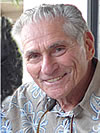
George Plafker
U.S. Geological Survey, Menlo Park
2017 Penrose Medal
Presented to George Plafker
Citation by Peter Haeussler
George Plafker discovered active subduction and illuminated its hazards. He recognized subduction in the 1960s from regional uplift and subsidence caused by the giant earthquakes in Alaska and Chile. Today, coseismic uplift and subsidence provide a tectonic template for assessing earthquake and tsunami hazards at subduction zones worldwide. The applications include subduction-zone paleoseismology, which George launched by measuring recurrence intervals in Alaska, and which he guided at Cascadia.
George also advanced understanding of Earth science in Alaska. Many of his Alaskan maps and syntheses integrate geology and geophysics. Some focus on bedrock geology, others on tectonic history, and still others on surficial processes. They shed light on the origins and collision of a microplate, subduction of a spreading ridge, and mechanisms of fjord tsunamis.
For his lasting contributions to plate tectonics, risk reduction, and regional geology, George Plafker merits the Penrose Medal.
2017 Penrose Medal — Response by George Plafker
Thinking back, I cannot even begin to thank all of the people who have helped me. There were friends who were there when I needed them and there was family. So I’m going to skip that, and I’m going to say, I wouldn’t even be here if it weren’t for an obscure geologist, a professor of geology who taught a single field course, or a single summer course at Brooklyn College, when someone was on sabbatical. I’ve never realized just how lucky I was.
This man is A.C. Hawkins.
He was a mineralogist and petrologist. He came into this class which was all civil engineering candidates. We all had to have one introductory geology course to go on to go into civil engineering at Brooklyn College. Turns out, he showed up the first day of the course, and he said, “Here’s the book we’re going to use in physical geology.” He said, “I can tell you right now that that’s not where you’re going to learn anything about geology. You have to go to the field.” And that’s something that I remembered forever. I mean, at least up till now. And so, when you have a problem, go to the field. You’ll find the data, and then you sometimes can solve the problems.
So anyway, he was just a widower, and so he offered to take whoever wanted to on field trips over the weekends. This was beyond physical geology course. Every weekend, I and four or five others would pile into his car from New Jersey and take a ferry across from Brooklyn College. We would tour around New Jersey, Pennsylvania, upstate New York, and we found out that there was something west of the Hudson River.
He knew all the places where there were quarries and mines and things where we could find specimens and see good structures. It was wonderful. We would end the field trip by going back to Hoboken, where you catch the ferry to go back to Brooklyn. He knew all the waterfront bars and where all the sailors hung out, and there was this one special one that he loved, it was the Clam Broth House. For a dollar or so, you could buy a beer, and you could drink all the clam broth you want, and they had a free sandwich bar, so you could have dinner, and we would sit there, and we would talk, and he would tell us all these great tales about working out in the field in Mexico and all other places, and so, like Yogi Berra said, “When you come to a fork in the road, take it.”
I took it. I took it hook, line, and sinker. I took it, and that was the beginning of 68 years of professional geology so far. I’m still at it. I want to thank the Penrose Medal Committee and all the members of the Survey and elsewhere who sent letters of support. This is a special honor. I also want to thank my family, for their patience, and putting up with all the times I was off in the field somewhere. Some of them were long trips, months or so, but they managed, and I thank them for their love and help. Thank you for being here.
